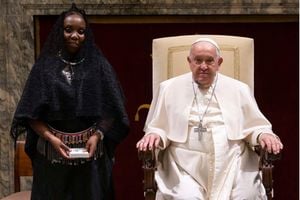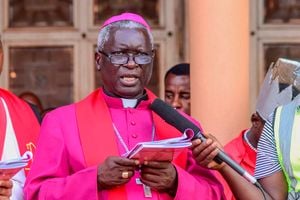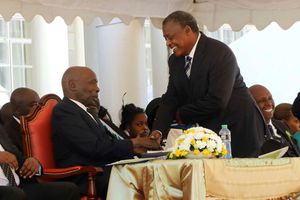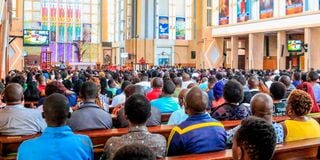
Worshipers at Holy Family Basilica Church in Nairobi follow proceedings as they celebrate Palm Sunday on March 24, 2024.
If you belong to the Luo community in Kenya or if you have close ties with someone from the lakeside counties, then you have probably heard the term ‘Jokopere’.
The origin of the term ‘Jokopere’, which has been synonymous with adherents of the Catholic faith in Luo Nyanza and other parts of Kenya for decades now, is deeply intertwined with the life and work of a Catholic missionary.
Father Pere Bouma, also recognised as ‘The Apostle of the Luo’, has remained a household name which has stood the test of time in the history of missionaries in East Africa.
Father Pere left an indelible mark on the region's cultural and spiritual fabric, making Catholicism part of the Luo identity.
The man of God arrived in Kisumu on January 19, 1904, during the early 20th-century missionary movements.
Born in Frisia, The Netherlands, he was sent to the Luo-dominated Nyanza region to spread Christianity under the Mill Hill Missionaries, English-speaking priests.
He, together with his colleague, Father Grimshaw, established a mission station at a place known as Ojola in Kisumu County.
From the Catholic archives, a telling story begins to emerge on how Bible translation into local languages defined faith and further set in stone cultural identity.
The missionaries and some volunteers carried the wooden frame of the mission structure from Kisumu town to Ojola, some 12 kilometres, on May 8, 1906. This formed the foundation for what is today the Mother Church of Luo Catholics.
The mission attracted the first Luo catechumens, including a local resident John Otieno, Father Grimshaw's helper, who nursed a strong eagerness to get baptised.
On June 13, 1906, Mr Otieno got baptised in Kisumu, his name changing to Joanno Robert.
Soon, he became Mr Grimshaw's interpreter, the number of new converts rising at an exponential rate.
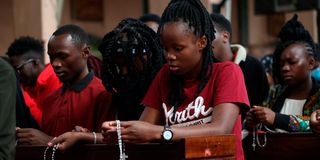
Youth pray at Holy Family Basilica in Nairobi on July 7, 2024 during a service dubbed Saba Saba Catholic Youth Mass in honour of those who died during the anti-Finance Bill protests.
Conscious of the need to transcend these cultural and linguistic barriers, Father Opere embarked on a serious quest to learn the Luo language and local culture.
By February 1907, he had written a Luo booklet entitled "Lukavirondo Primer," which was an initial step in providing a source for the dissemination of Catholic teachings to the Luo people.
His work was not restricted to Ojola. In 1909, he made long journeys throughout the region, establishing catechumenate in places west of Ojola and the Kano Plains to the east of Kisumu.
The Dutchman compiled a Luo prayer book, printed in Austria, which arrived in 1910, as well as his groundbreaking grammar book "Elementary Grammar of the Nilotic-Kavirondo Language (Dholuo)".
He also wrote a pamphlet entitled "Kiki" in Luo, meaning "Don't," which were rules of behaviour for Christians.
When the first 12 rules he had put down became very popular, he extended it to 51 rules.
Waves of fever and plague on Ojola's hill made the place inhospitable and plans were laid to transfer the mission.
In 1914, Father Opere and Father Bergmas initiated a new church at a place called Aluor in Gem-Yala, Siaya County - a very active centre of Catholicism.
The move, however, did not go down well with Ojola people who, up to date want their mission restored. Under the first Luo Bishop Zacchaeus Okoth, Ojola Mission was revived in 1979.
At Aluor, he faced trials: the partial burning of the mission by lightning and opposition to his plan to move further to Ugenya.
Despite all that, he did not lose faith and expanded to the new catechumenates at Yala and Pap Boro, where he was expected to prove his divine call by bringing rain in a drought-stricken region.
According to Father Hillary Awiti, Regional Representative of the Mill Hill Missionaries in East Africa, Opere was the name that came from the locals due to the inability to pronounce his name, Pere Bouma.
Read: The truth shall set you free: Cordial relationship between Ruto government and Church is fast fading
"The followers and locals of Father Pere Bouma could not pronounce his name, so they gave him the name Opere Boma. The spread was like a magic bullet and as a result, people who prayed with him became known as Jokopere," said Father Awiti in an interview with Nation.Africa.
According to the priest based in Arusha, Tanzania, the coined name was a strong element in helping to spread Christianity across Nyanza.
"By coining the name, the locals owned the faith. And when the natives own the faith, it spreads. It no longer appears to be a faith that has been brought from outside. Now it is their own,” he said.
"When those missionaries came, they found us with different religions. It's already there. But now how to internalise, and accept the use of the word Opere helps to spread the message, and help people to own it. That was a very strong element in helping to spread the word, the message and localisation.”
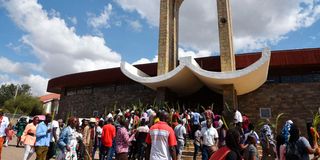
Worshippers enter Christ the King Cathedral Church in Nakuru City on March 24, 2024 for the Palm Sunday service.
He added "At that time, for them to succeed in spreading the gospel, they had to know the language. That is always the key to any work you're going to do as a missionary. So when they came here, the first thing they did was to learn the local language, interact with the people, know their language, know their culture.”
As the only black Mill Hill Missionary in East Africa, Father Awiti acknowledged the impact of learning the local language and culture.
"When you go to a different place as a missionary, your first task is language. Learn the language. Not only language but culture as a whole. So that is the key to evangelisation. If you don't know the language, how are you going to spread the message? And we emphasize that. There is always an interaction between Christianity and the local culture. And that interaction cannot take place if there's no work if there's nobody who learns the language of the other,'' he asserted.
Father Emmanuel Amolo, the first diocesan priest to take over the administration of St. Joseph's Milimani, Kisumu from the Mill Hills-whites as the parish priest in 2009, said that Father Opere's legacy bridged cultural divides and led to the spreading of the faith.
"His efforts in translating the Bible into Dholuo remain a cornerstone of his contributions to the Luo community," he said.
"Father Opere, to the Luo a beloved ‘Opere Boma’, left his mark in this region. He was celebrated in songs like ‘Tiga ng'ute bor (The Giraffe-Opere- has a long neck)’ to commemorate his presence that was towering both spiritually and physically. His work laid the ground for Catholicism in Luo land. Combining cultural respect with unyielding faith,” he added.
Nerbert Odhiambo, 86, a devout Catholic and a long-time worshiper at Ojola, the first Luo church, recalls the origins and evolution of the term Jokopere.
Mr Odhiambo recalled the term was first coined in Ojola before spreading to Aluor and eventually to other parts of the region and country.
“In Aluor, several individuals joined the church under the leadership of Father Opere. Recognising their commitment, Opere sent some of these devoted members to spread the gospel across the defunct Kavirondo area. This group of evangelists often traveled as a community using a lorry, which led to them being nicknamed Jokopere weg lorry, loosely translated to ‘People of Opere, the owners of a lorry,’” he explained.
The octogenarian reflected on the deeper significance of the term Jokopere and its role in preserving a rich history of faith.
“As a member of the Catholic community, the identity as Jokopere embodies a legacy of faith, resilience, and cultural integration. The name is more than just a label; it represents the transformative power of mutual respect and understanding in spreading the faith,” he said.
For Mr Odhiambo, the name Jokopere is a reminder of the early missionaries’ efforts to connect with local communities by embracing their culture and language. It also highlights the dedication of local converts who carried the mission forward, ensuring that the Catholic faith took root and flourished in Luo land.
“The story of Jokopere is not just about a name; it is about a people who owned the faith, making it their own and passing it on to future generations,” he added.

